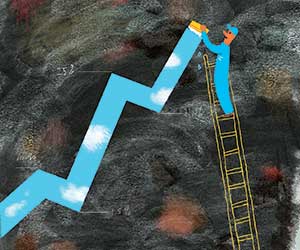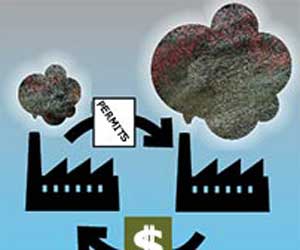
Illustration: Marc Rosenthal
though it’s not been mentioned much lately amid the sea of bailout headlines, the global economy isn’t the only thing melting down right now. So are the polar ice caps. As nasa climatologist James Hansen has warned, we are nearing—if we haven’t already passed—the tipping point at which the concentration of carbon in the atmosphere becomes so high that feedback loops will cause it to keep increasing on its own even if humans never emit another CO2 molecule again. To keep the planet habitable, he says, we must cut emissions not 10, not 20, but a full 80 percent by 2050; anything short of that will lead to “global cataclysm.”
Fine then. We need to fix the climate, and we need to start yesterday. President Obama plainly understands this. His environmental rhetoric has focused mainly on things like wind farms and green jobs, but the backbone of his climate policy is actually an ambitious program that, if done right, will reduce greenhouse gases and raise desperately needed revenue—and, most important of all, has a fighting chance of making it through the congressional sausage factory in one piece. If he sticks to his guns, the idea will be a household term before the year is out. It’s called cap and trade, and it springs from a simple yet surprisingly hard-to-answer question: What’s the best, and fastest, way to reduce pollution?
When serious environmental regulation began in the late ’60s, the default approach was “command and control,” which is exactly what it sounds like. Take, for example, the Clean Air Act of 1970. It gave the government power to regulate six airborne pollutants, and the epa did this by setting firm limits on these pollutants. That’s the command part. States then developed various mechanisms for meeting epa standards; one was to require companies to install “Best Available Control Technology” for reducing pollutants. That’s the control part.
Command and control works: Back in the mid-’70s, Los Angeles, the smog capital of the country, suffered through 200 days per year of ozone levels above the federal standard. Today it has fewer than 100. But is there a better way? More to the point, is there a cheaper, more flexible way? Enter cap and trade, a concept that’s been the go-to approach in environmental wonk circles for years.
The theory is straightforward. Suppose you have two plants, and the first one is able to eliminate one ton of pollutants at a cost of $10,000. The second plant, perhaps because it uses a different fuel or newer boiler technology, can do the same for only $4,000. Under command and control, if you required them to remove one ton each, the cost would total $14,000.
But what if all you mandated was that two tons of pollutants be removed overall (the cap part) and allowed the plants to work out how to do it? Naturally, the first plant would just pay the second plant $4,000 to remove an extra ton of pollutants from its emissions (the trade part). At first this seems suspect: The first plant is being allowed to merrily pollute away. But you’ve still removed two tons of pollutants, and since it was done more cheaply—for $8,000 instead of $14,000—you can afford to ratchet down the cap. You can require that three tons of pollutants be eliminated overall, and since this still costs only $12,000, everyone comes out ahead. The public gets cleaner air, and the plants save money.
Sounds great, you say, but does it work in practice? We found out in 1990, when the Clean Air Act was modified to address acid rain pollution caused by sulfur dioxide from coal-fired power plants. Instead of requiring every plant to install a specific cleanup technology or meet a specific emission rate, the epa simply set a nationwide cap on the total volume of SO2 emissions and required power plants to own a permit for each ton of SO2 they emitted. Each plant was allocated a certain number of permits, and if a plant reduced its emissions to the point where it didn’t need all its permits, it could sell them to the highest bidder.
The results were better than anyone expected. According to figures collected by the Environmental Defense Fund, power plants regulated under the Clean Air Act didn’t just meet the cap but ended up with about 20 percent lower emissions overall—at about one-third the cost estimated before the law’s passage. Not all of that extra reduction was due to the trading option, but it’s clear that the flexibility of the permits—and the chance to make money by selling them—motivated plants to cut emissions as much as possible, as cheaply as possible. (You can check out the emissions market for yourself, if you’d like, the same way you’d check an online broker to see how your stocks are doing. At press time, emissions-credit broker Evolution Markets listed a permit for a ton of SO2 at about $185.)
Carbon emissions, given that they are perhaps the defining feature of our economy, are a more daunting problem than SO2 ever was. No single proposal will solve the problem—not solar panels, wind farms, green buildings, better cars, new train lines, or new power plants. But if there’s a single force that can help drive all the other innovations we need, it’s putting a price on carbon emissions. That’s the base on which we’ll build everything else. And the way that price will be set, it now seems, is the stuff of an epic political battle that will begin this spring if Congress takes up a global warming bill. So as the rhetoric heats up, here are the 10 key things to keep in mind.
1. Price matters. Honest. The whole point of cap and trade is to raise the price of emitting carbon. If power plants have to buy a $100 permit for every ton of carbon they emit, the price of electricity will go up, and people will use less of it. Likewise, if refineries have to buy a permit for every ton of carbon their gasoline produces, the price of filling your tank goes up, and you end up driving less.
True, this effect sometimes takes a while. Gasoline prices in the United States more than doubled between 2002 and 2007, for example, and drivers barely responded. In economic lingo, the “elasticity” of gasoline consumption is low: It takes a big increase to make any kind of impact on people’s driving habits. Nonetheless, it does work. Total miles driven started to flatten out in 2006 and finally dropped sharply last year, when a gallon of regular hit $4. (Interestingly, driving hasn’t increased significantly since—economists blame the recession.)
What’s more, price signals allow all of us to cut our carbon use in our own way, instead of being stuffed into a regulatory straitjacket. For example, driving and eating meat are both fairly carbon intensive. If the government requires everyone to cut back on their gas use and meat consumption equally, most of us will have something to be unhappy about: Maybe I really love my sirloin, and you’re attached to your suv. But if instead it raises the price of carbon—an increase that will be reflected in the price of carbon-intensive goods—we’ll each give up the thing we care about least simply because the cost has gone up. You might keep your Jeep and eat more tofu, while I’ll keep eating steak but buy a Prius. And carbon is reduced just as much.
2. Yes, it’s basically a tax. If you think that buying a $100 permit to emit a ton of carbon is pretty much the same thing as paying a tax of $100 per ton of carbon, you’re right. And if you talk to economists, you’ll find that most of them actually prefer a straight tax. It’s simpler, more consistent, and more predictable. Dan Rosenblum of the Carbon Tax Center, which advocates a straight-up tax, calls that approach the “gold standard” and asks, “If you’re going to have a tax, why not have the best possible tax?” Even some conservative economists, like Greg Mankiw, a former chairman of George W. Bush’s Council of Economic Advisors, support a carbon tax as a way of more accurately capturing the true economic cost of carbon emissions.
Cap-and-trade plans have a couple of specific disadvantages over taxes. They produce economic uncertainty because permits are sold on the open market and prices vary the same way stock prices do; that’s a problem for companies trying to decide which technologies are worth investing in. As Rosenblum puts it, “If you don’t know where prices are going to be in two or three years, you can’t invest rationally.” Moreover, international trade organizations have a lot of experience harmonizing taxes and tariffs, but they haven’t been very good at setting quantitative rules for how much pollution should be allowed. And since the entire world eventually needs to agree on a set of carbon pricing tools, this matters. A lot.
Cap and trade can also mesh poorly with local rules. If Colorado passes a regulation that cuts electricity use, for example, its utilities will pollute less and need fewer emission permits, which means the cost of permits goes down. But if the cost of permits goes down, then utilities in other states will increase their emissions to the point where the Colorado rule might have no net effect at all. Because of these two problems, says Dallas Burtraw, an economist at Resources for the Future, “the tax approach, on net, wins in my mind.”
Except it’s not so simple. As Grist‘s David Roberts has pointed out, “The carbon tax that economists talk about is a whiteboard tax”; in real life, things are messier. Congress loves nothing more than fiddling with the tax code to favor one interest group or another, and corporate America knows better than to assume that today’s levies will be the same tomorrow.
The basic tradeoff is this: With a tax, you know exactly what the price of carbon will be, but you don’t know for sure how much carbon reduction that tax will get you. You have to guess. With cap and trade, you don’t know for sure how much carbon will cost, but you do know exactly how much carbon reduction you’ll get. Whatever technical flaws cap and trade may have compared with taxes, this by itself is enough to convince most environmental groups that it’s a superior approach.
3. Europe is already doing it. In 2005 the European Union started phase one of its Emission Trading Scheme. The initial rollout was a fizzle. Too many permits were allocated, enforcement was weak, and permit prices dropped to as low as 2 cents per ton by the end of 2007. As early as 2006, one major European environmental group was already complaining that “lax implementation of the ets is a major disappointment.”
But phase two, which began in 2008, has proved more robust. At press time, CO2 permits were selling for about $17 per ton. That is still too low, but the plan is for cap levels to decrease in the future and for more industries to be brought under the ets umbrella. As that happens, the price of permits will continue to rise, and the market will work its magic.
The EU is fully committed to cap and trade. If the United States wants to be part of a global carbon reduction strategy, learning from the ets and eventually integrating with it is probably our best bet.
4. There’s no such thing as a free permit. One of the key issues with any cap-and-trade system is how you allocate permits. Power plants would like to get them for free, and at first glance this seems appealing. If you set the overall carbon cap at 90 percent of current levels, and allocate only that number of permits, that should reduce carbon without raising prices for the consumer. After all, the power plants didn’t have to pay for the permits, so there are no costs to pass along. Right?
Oddly enough, no. The economic theory involved is a little hairy, but those permits have a value on the open market, and that means that in many cases marginal producers can make more money selling their permits than by producing power. They’ll only be willing to produce power if they can raise prices enough to make the power-producing business more profitable than the permit-selling business, and eventually everyone will jack up prices to follow suit.
This may sound abstract—even a bit fantastical—but it’s absolutely real. In fact, when permits in phase one of Europe’s ets system were handed out for free, electricity prices rose and power companies pocketed a windfall profit (which Britain’s Department of Trade and Industry estimated at about $1.1 billion a year in the UK alone). Dale Bryk, an attorney with the Natural Resources Defense Council (nrdc), puts it bluntly: “If you ask them point-blank if they’ll charge customers for free permits, they won’t tell you. But they know they will.”
A better way is for the government to hold an auction to set the price of permits. This has a couple of extremely salutary effects. First, it puts everyone on a level playing field (since Congress has no ability to allocate permits to favored interests). Second, and even better, the money from selling the permits goes to the federal government, not to the carbon emitters. That’s a pretty useful revenue stream, one that would probably start out at about $20 to $30 billion per year and go up steadily as the cap came down and the price of carbon permits increased.
5. It matters what you do with the money. One of the problems with cap and trade, as with any energy tax, is that it’s regressive. In absolute terms, poor families spend less on energy than rich families, but they spend a greater share of their income, and this means that higher energy prices hit the poor especially hard. The Congressional Budget Office, for example, estimates that the price increase from a moderate cap-and-trade plan would cost low-income families 3.3 percent of their income, compared with only 1.7 percent for better-off families. Reducing greenhouse emissions may be a global priority, but should it be done on the backs of the poor?
In a cap-and-trade system where permits are given away, there’s nothing you can do about this. In fact, because the windfall profits of such a system benefit shareholders in fossil fuel firms, who are generally high earners, you really would be taxing the poor to benefit the rich.
But in a system where carbon permits are auctioned off, this imbalance can be addressed. James Boyce and Matthew Riddle of the Political Economy Research Institute favor a policy called “cap and dividend,” which rebates 100 percent of the auction revenue back to the public, much the way that Alaska issues checks to its residents based on tax revenue from the oil industry. Alternatively, the Center on Budget and Policy Priorities has proposed a “climate rebate” program aimed exclusively at poor families that allocates 14 percent of permit auction revenues to replace the buying power that low-income households would lose from higher energy prices. (Families would get the money via existing, proven programs such as the earned income tax credit.) The rest of the revenue stream would be left over for investments in energy efficiency, mass transit, and green R&D.
This also might make cap and trade attractive to politicians who are wedded to congressional pay-as-you-go rules (which prevent spending on new programs unless there are new tax revenues to pay for them). “Given the fact that Democrats want to stick to paygo rules and no one wants to raise middle-class taxes,” says Tony Kreindler of the Environmental Defense Fund, “an auction starts to look very attractive.”
6. Technology innovation is key. One reason the acid rain cap-and-trade program worked so well is that it didn’t require inventing any new technology. That’s decidedly not the case for carbon. Here, cap and trade needs to fairly quickly generate prices high enough to not just prompt us to drive less, insulate our houses better, and install more solar panels. To get to the 80 percent reduction we need, we also need major technology breakthroughs—what economist William Nordhaus calls “radical innovation.” That’s going to happen only if the price is so high that people can make a lot more money by eliminating carbon than by emitting it.
7. Cap and trade is politically feasible. As Kreindler says, “Mention the word ‘tax’ in Washington and everyone runs behind a tree.” Even 15 years after the fact, Democrats still talk nervously about being “Btu-ed,” a reference to the Clinton administration’s proposed energy tax in 1993, which some House Democrats blamed for losing their seats in the 1994 Republican landslide. Cap and trade’s market-friendly trading mechanism, combined with the fact that the acid rain program was so successful, makes it far more likely than a tax to survive on Capitol Hill.
8. The cap needs to keep coming down over time. Kreindler advises that the most important part of an effective cap-and-trade plan is setting a short-term target that prompts substantive action right away. A good place to start, he says, would be to plan on a 2012 launch with the cap targeted to provide a 20 percent reduction in carbon emissions by 2020. But that’s only the beginning. “It’s important to keep compliance costs low at first in order to maintain political support,” Kreindler says. But if we want to eventually reduce emissions by 80 percent, the cap has to keep coming down year after year—and it should do so at a predictable rate. If businesses know what the cap level will be in future years, they can estimate carbon costs more reliably and make green investments more rationally.
9. You have to get the details right. There are plenty of bells and whistles you can build into a cap-and-trade program. A safety valve, for example, sets a maximum price on permits, providing some predictability. A circuit breaker does much the same thing by freezing the cap level if the price of permits gets too high. Banking, a feature of the acid rain program, allows carbon emitters to hold on to permits in years when they don’t need them and then use (or sell) them later. Finally, and most controversially, there are offsets. A power plant in Georgia might fund tree-planting programs in the Amazon to earn permits, for example, which seems like a good idea at first glance. But who’s going to check that those trees really get planted and really stay put? Offsets can be useful, but tight regulation is critical.
10. It’s not a panacea. “Cap and trade is just a tool,” says the nrdc‘s Bryk. It might be the backbone of any effective long-term carbon reduction policy, but it’s not the only tool we need. Or even necessarily the best. If you want to improve vehicle mileage, for example, raising federal fuel-efficiency standards is “much cheaper for consumers than raising the price of gas,” she says. Michael O’Hare, a public-policy professor at UC-Berkeley, emphasizes the need for the government to take a more active role than just setting carbon prices. Sure, higher energy prices might motivate people to change their behavior. “But,” he points out, “even if I want to take the tram, I can’t do it if there’s no tram.”
In other words, command and control will remain absolutely necessary. As will taxes. Even with a well-designed cap-and-trade plan in place, we’ll need tougher efficiency standards, higher fuel taxes, more sensible land-use policies, green research programs, and plenty more. But in the same way that cutting calories is the core of any weight loss no matter which fad diet you follow, raising the price of carbon is the core of any climate plan. With luck, this could be the year we finally figure that out.
















